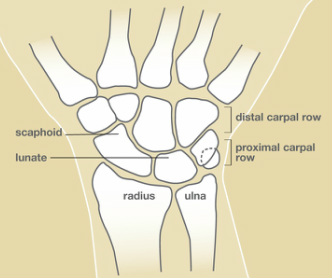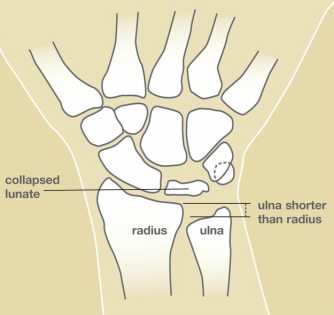MAKE AN APPOINTMENT TODAY!
Kienböck DiseaseKienböck disease or Kienböck's disease is a problem in the wrist caused by the loss of blood supply to the lunate. The lunate is one of the eight small bones that make up the “carpal bones” in the wrist (see Figure 1). There are two rows of bones: one closer to the forearm, the “proximal row;” the other closer to the fingers, the “distal row.” The lunate bone is in the center of the proximal row. It is next to the scaphoid bone, which spans the two rows.
Kienböck Disease CausesThere is probably no single cause for loss of blood supply to the lunate. The cause of Kienböck disease
seems to involve multiple factors. These factors include the blood supply (arteries), the blood drainage (veins), and skeletal variations. Skeletal variations associated with Kienböck ’s disease include a shorter length of the ulna, one of the forearm bones, and the shape of the lunate bone itself (see Figure 2). There may be some cases that are associated with diseases like gout, sickle cell anemia, and cerebral palsy. Trauma, either a single event or repeated significant trauma, may affect the blood supply to the lunate. In general, though, Kienbock disease is not felt to be related to occupational hazards. However, the presence of Kienböck disease can affect the treatment and prognosis for traumatic events. |
Kienböck Disease DiagnosisMost patients with Kienböck disease present with wrist pain. There is usually tenderness directly over the lunate bone. The diagnosis of Kienböck disease is made by history, physical examination, and plain x-rays. Special studies are sometimes also needed to confirm the diagnosis. Probably the most reliable special study to assess the blood supply of the lunate is Magnetic Resonance Imaging, or MRI. CT scanning, specialized CT scanning, and bone scan may also be used.
Kienböck Disease SymptomsThe progression of Kienböck disease is variable and unpredictable. Sometimes the disease may be diagnosed at a very early stage. At this time, there may be only pain and swelling, and normal x-rays. As the disease progresses the x-ray changes in the lunate become more obvious. With further progression, the lunate develops small fractures and the bone fragments and collapses. As collapse occurs, the mechanics of the wrist become changed, which puts abnormal stresses and wear on the joints within the wrist itself. One should be aware that not every case of Kienböck disease progresses through all stages to the severely deteriorated arthritic end-stage.
Kienböck Disease TreatmentLess severe thumb arthritis will usually respond to non-surgical care. Arthritis medication, splinting and limited cortisone injections may help alleviate Treatment options depend upon the severity and stage of the disease. In very early stages, the treatment can be as simple as observation or immobilization. For more advanced stages, surgery is usually considered to try to reduce the load on the lunate bone by lengthening, shortening, or fusing various bones in the forearm or wrist.
|
Sometimes bone grafting or removal of the diseased lunate is performed. If the disease is very advanced and the relations of the bones one to the other have markedly deteriorated, complete wrist fusion may be the treatment of choice.
Hand therapy does not change the course of the disease; however, hand therapy can help to minimize the disability from the problem. Treatment is designed to relieve pain and restore function. Your hand surgeon will advise you of the best treatment. Your hand surgeon can explain the risks, benefits, and side-effects of various treatments for Kienbock disease.
The results of Kienböck disease and its treatment vary considerably depending on the severity of the involvement, and whether or not the disease progresses. The disease process and response to treatment will take several months. On occasion, several forms of treatment, and even multiple operations, might be necessary.
Hand therapy does not change the course of the disease; however, hand therapy can help to minimize the disability from the problem. Treatment is designed to relieve pain and restore function. Your hand surgeon will advise you of the best treatment. Your hand surgeon can explain the risks, benefits, and side-effects of various treatments for Kienbock disease.
The results of Kienböck disease and its treatment vary considerably depending on the severity of the involvement, and whether or not the disease progresses. The disease process and response to treatment will take several months. On occasion, several forms of treatment, and even multiple operations, might be necessary.
Reproduced with permission from the American Society for Surgery of the Hand www.handcare.org
Disclaimer and Privacy
IZADIHAND.COM © 2011-2022 Kayvon David Izadi MD - All Rights Reserved
Webmaster
IZADIHAND.COM © 2011-2022 Kayvon David Izadi MD - All Rights Reserved
Webmaster


